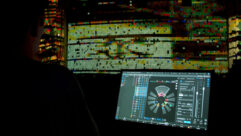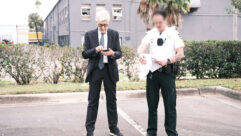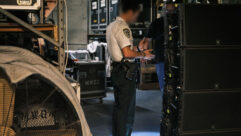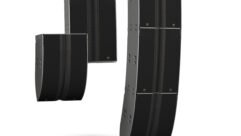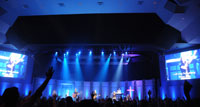

Product at Work: L-Acoustics KARAi
Jan 13, 2012 4:18 PM
Christ Fellowship Gardens features the very first L-Acoustics KARAi installed in the U.S. The system is also made up of two four-box SB18i sub arrays, each arranged in a cardioid configuration as well as two SB28 subs positioned on the floor beneath each KARAi array.
One year ago this month, L-Acoustics debuted the KARA modular line source system to the US. The KARA is the successor to the company’s venerable dV-DOSC, which has a worldwide roster of installations, perhaps most famously as the voice of God in the Broadway hit The Book of Mormon. The KARA was designed for lighter weight, more maximum output, better horizontal dispersion (110 degrees full-bandwidth), 10 degrees of vertical dispersion (opposed to 7.5), and captive rigging system. Both KARA and KARAi use the same compression drivers as L-Acoustics K1, the company’s flagship large-format touring loudspeaker.
The KARAi differs primarily in its rigging, which for fixed installation can be a bolt-and-plate assembly—much less costly than the KARA’s quick-pin-release rigging that serves the rental and touring market.
The very first permanent installations of this product were in houses of worship—at Jesus House in the U.K. and at Christ Fellowship Gardens in Florida. Both midsized churches support highly contemporary concert-style programming. Just last month, the KARAi line also went into a very different type of church, a 50,000-square-foot facility where the intimacy and intelligibility of the pastor’s sermon needed to reach into every corner.

Jesus House’s setup includes a right/left system of six KARAi per side, powered by two LA8 amplified controller, one for each hang. Four SB18i subwoofers per side are built into the stage and two 12XTi coaxials act as front fill for the KARAi system, and three further 12XTis are flown at the back of the venue to cover a small balcony.
Concert-oriented Sound
Jesus House is a 2,000 capacity church in North London owned by the Redeemed Christian Church of God (RCCG). Worship style is contemporary/gospel, and it was clear that the facility needed a concert-oriented system.
The integrator, SFL Group chose the system because as a bi-amped product, KARAi could keep up with what the programming demanded in terms of sound pressure levels. “lt has loads of high-frequency headroom, so even when the box is pushed hard, it maintains a high degree of clarity,” says technical director Mark Payne. Payne was also swayed by KARAi rigging.
The building—a warehouse conversion—has an audience area of approximately 80ft. wide by 200ft. deep, covered by a right/left system of six KARAi per side, powered by two LA8 amplified controllers, one for each hang. Four SB18i subwoofers per side are built into the stage, not to obscure the congregation perspective. Two12XTi coaxials act as front fill for the KARAi system, and three further 12XTis are flown at the back of the venue to cover a small balcony.

“It’s a very efficient system,” Payne says. “It has a huge amount of bass and high-frequency headroom for the client’s current requirements, but they’re a fast-growing organization and see themselves in this venue for five years maximum, so we needed a product that could be scaled up when necessary.”
“One just wonders how far it can go before it runs out of headroom” says Ayo Olunloyo, head of media at Jesus House. “The response from the congregation has been more than positive.”
Meanwhile, in Palm Beach Gardens, Fla., Christ Fellowship Church took the first U.S. delivery of the KARAi and SB18i enclosures for it’s 2,200-seat flagship worship center (one of four campuses that serve 16,500 congetants).
Alan Jones of Pro Sound and Video’s Miami location helped facilitate the sale and installation of the new system, which featured the very first KARAi and SB18i. The system, designed in L-Acoustics SoundVision software, features three KARAi arrays flown in an LCR configuration (8+9+8 KARAi) concealed in soffits above the stage of the 2,200-seat octagonal sanctuary. Two four-box SB18i sub arrays, each arranged in a cardioid configuration providing focused low-frequency extension for the KARAi mains, are flown in the two spaces between the KARAi, and two SB28 subs are positioned on the floor beneath each KARAi array.
Product at Work: L-Acoustics KARAi
Jan 13, 2012 4:18 PM

At New Life Community Church, two arrays of four KARAi enclosures fly above the left and right sides of the stage with a single 12XTi per side. Four SB18i subs are built into the front of the stage.
The church also is using a number of L-Acoustics’ coaxial enclosures, including one 115XT HiQ flown per side to provide extreme left and right downfill, plus seven 8XTi mounted to the front of the stage, below the stage lip, for frontfill. The entire loudspeaker complement is powered by a combination of LA8 and LA4 amplified controllers equipped with LA-AES3 (AES/EBU) cards for digital signal distribution.
Danny Dagher, senior audio engineer at Christ Fellowship Gardens, notes that the church essentially drove the specification for the L-Acoustics system. “We invited four respected loudspeaker manufacturers to come participate in a comparative listening test to help us discern which system would be the best solution for our room,” Dagher says. “So we brought in our entire worship and media staff—there were more than 30 of us critically listening to the shootout—and we unanimously came to the consensus that KARAi was the right box.”
“Our previous house system was an exploded mono cluster design, which was a comb-filtering nightmare,” says tech Travis Groat. “So to go from that to L-Acoustics has been absolutely shocking. The intelligibility of KARAi is breathtakingly clean, but without the fatiguing sterile harshness that one can experience on other PAs. “I think the greatest thing I can say about this system is that whatever comes through it simply sounds like the source; it’s exactly like listening to a pair of high-end studio reference monitors.”

Message-driven Sound
In moving to a new 50,000-square-foot home, New Life Community Church of Oxnard, Calif., didn’t want to lose the core of their mission: inspiration communication.
“Although everyone loves music, the single most important element of a worship service is the spoken word,” says Richard Rutherford, VP at Rutherford Design in Northridge, Calif., who specified the system. “When designing a sound system, I jokingly tell pastors that I’m not concerned about the people in the front seats because they’ll be here next week no matter what. My goal is to help the pastor deliver his message in an intimate way to what might normally be viewed as the worst seats in the house—the ones at the back and far sides—because those will usually be where first-time visitors will sit. The pastor has to be able to communicate to them as if they’re sitting on the front row; it has to be an excellent experience for them.”
Collaboratively designed by Rutherford and L-Acoustics’ Dan Palmer, the system’s integration was chiefly coordinated by Rutherford Design field technician Andrew Bacon and David Myers, director of installations for Rat Sound Systems, which also provided the sale of the system.
As with most churches, the heart of New Life’s facility is its sanctuary, which seats a little less than 1,000 people—making it one of the city’s largest auditoriums. Arrays of four KARAi enclosures flown above the left and right sides of the wide stage deliver the primary house coverage with a single 12XTi per side to address the extreme left and right seating areas.
A total of four SB18i subwoofers built into the front of the stage provide the room’s low-frequency reinforcement. Each sub position is also equipped with a single 8XTi to bring the sound image down to the stage for the first few rows. All of the L-Acoustics loudspeakers are powered and processed by three LA8 and one LA4 amplified controllers housed in a 42RU rack at stage left.
The church got what they were looking for in terms of speech intelligibility, though Rutherford also considered KARAi’s suitability for music reinforcement. “I’m a big believer in headroom,” he says “ I’d rather provide 30 extra decibels that a church might never use instead of having them wish for six more they simply don’t have. On paper, a smaller system—such as L-Acroustics’ Kiva—could have done more than enough for the room, but the KARAi offered that extra 15dB at the back of the room that filled the space with a much bigger, in-your-face sound should they ever need it. Having that level of impact and intelligibility be omnipresent throughout the entire room really draws people into the worship experience so much more.”


